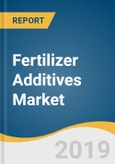The global fertilizer additives market size is projected to reach USD 4.01 billion by 2025, according to this report. Decreasing per capita arable land and rising population density has resulted in increased demand for fertilizers in the agriculture sector, which in turn has boosted the growth.
The growing fertilizers industry and limited availability of farmland are the key drivers for the global market. However, harmful effects of fertilizers on environment along with lack of awareness & availability of the product in underdeveloped economies is expected to have a negative impact on the industry.
The Asia Pacific was the largest fertilizer additive market in 2018 and accounted for 53.1% of the volume share. The robust growth of the agriculture sector in this region is one of the main factor driving the industry. In countries like India and China, the population explosion has significantly impacted the agriculture sector.
China is one of the developed countries in the Asia Pacific region with a constantly growing agricultural sector and advancements in terms of innovations and new technology development. Due to the population explosion, the amount of arable land in China has reduced severely over the past two decades. This factor has increased the demand for fertilizers, resulting in the growth of the additives market.
Further key findings from the report suggest:
This product will be delivered within 1-3 business days.
The growing fertilizers industry and limited availability of farmland are the key drivers for the global market. However, harmful effects of fertilizers on environment along with lack of awareness & availability of the product in underdeveloped economies is expected to have a negative impact on the industry.
The Asia Pacific was the largest fertilizer additive market in 2018 and accounted for 53.1% of the volume share. The robust growth of the agriculture sector in this region is one of the main factor driving the industry. In countries like India and China, the population explosion has significantly impacted the agriculture sector.
China is one of the developed countries in the Asia Pacific region with a constantly growing agricultural sector and advancements in terms of innovations and new technology development. Due to the population explosion, the amount of arable land in China has reduced severely over the past two decades. This factor has increased the demand for fertilizers, resulting in the growth of the additives market.
Further key findings from the report suggest:
- Urea end-product accounted for the largest share of 52.5%, in terms of volume, in 2018 due to the availability of the highest nitrogen content as compared to other soluble fertilizers
- The anti-caking function dominated the industry with a share of 36.5% in 2018 owing to the fact that it helps in maintaining the fertilizer quality by preventing formation of flakes and cakes
- North America accounted for 14.1% of the global fertilizer additive market, in terms of revenue, in 2018 owing to government initiatives to promote the agricultural sector by providing subsidies on the purchase of fertilizers
- Brazil leads the regional market in Central & South America with agriculture GDP contributing 23.5% in its total economy
- Some of the key industry participants are KAO Corporation, Clariant, Novochem Group, Solvay, Forbon Technology, Filtra Catalysts & Chemicals Ltd, ChemSol LLC, and Michelman
This product will be delivered within 1-3 business days.
Table of Contents
Chapter 1 Methodology and Scope
Chapter 2 Executive Summary
Chapter 3 Market Variables, Trends & Scope
Chapter 4 Fertilizer Additives Market: Function Estimates & Trend Analysis
Chapter 5 Fertilizer Additives Market: End-Product Estimates & Trend Analysis
Chapter 6 Fertilizer Additives Market: Regional Estimates & Trend Analysis
Chapter 7 Competitive Landscape
Chapter 8 Company Profiles
Companies Mentioned
- Clariant AG
- KAO Corporation
- Dorf Ketal Chemicals (I) Pvt. Ltd.
- Solvay S.A.
- ArrMaz
- Chemipol S.A.
- Cameron Chemicals
- Michelman, Inc.
- Tolsa SA
- ChemSol, LLC
- Emulchem
- Borregaard LignoTech
Methodology

LOADING...








